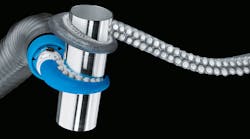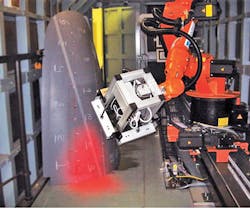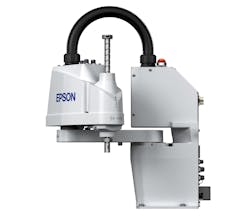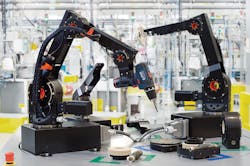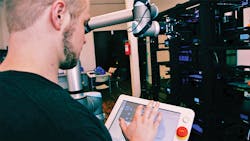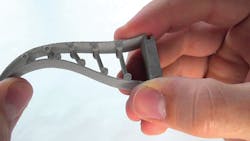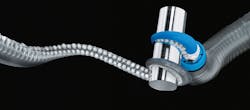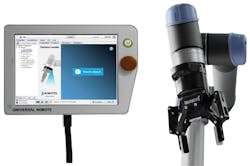Download this article in PDF format.
In manufacturing, the part produced at lower cost and in less time than the competition will usually come out on top. Investing in automation, the Industrial Internet of Things, and machine vision are helping companies accomplish this and become more competitive.
However, as large, advanced automation equipment progresses, the expense can hinder return on investment (ROI). This has led to dynamic systems that can be integrated quickly and easily into production with a cost-effective price tag. Nowhere is this more evident than with robotic arms. This article will walk through trends in robotic arms, and what engineers should think about before placing an order for a shiny new piece of equipment.
Lower Barrier to Entry
“We're constantly breaking down the mental and financial automation barriers that our end users face,” says Esben Østergaard, CTO and Co-founder of Universal Robots (UR). “According to the old rule of thumb, the cost of a robot would be equivalent to one worker’s two-year salary. But collaborative robots are closer to one fourth of that price. With traditional robots, the capital costs for the robots themselves account for only 25% to 30% of the total system costs. The remaining costs are associated with robot programming, setup, and dedicated, shielded work cells.
“…with a collaborative robot, [installation] is typically less than an hour. That’s the time it takes to unpack the robot, mount it, and program the first simple task through an intuitive touchscreen user interface. Or, by simply grabbing the robot arm, showing it the desired path of movement.”
Typically, one of the first factors to impact ROI is the equipment’s cost. The initial price may also reduce access to technology simply because a company may not have the capital. For example, there are significant advantages to using composite automation equipment, but most companies still do many of the processes manually because of the cost and skill needed to run such equipment.
In the composite industry, automation often involves one-offs, or is complex. This is why, despite the known value of automating a composite line, many companies still rely on skilled technicians to make composite parts. Companies like Electroimpact have advertised feed rates of up to 660 lbs. per hour for a given machine and part configuration. Meanwhile, manually laying up parts might produce two to three pounds per hour.
In addition, the automated machines aren’t completely user-friendly, and there’s still a learning curve. The cost and time to integrate automation equipment are the main reasons companies aren’t investing, despite the proven advantages.
Having in-line testing and inspection is desirable, so that parts don’t have to be removed from production and manually inspected. In addition, in-line inspections are non-destructive. Non-destructive testing (NDT) means production can immediately be increased by the percent of parts tested (if they test properly). Also, NDT in-line can test more parts that may offer data to the process, including how the process can be adapted to prevent parts from ever testing poorly. (Source: CompositeWorld.com)
Subscription Model
One trend that’s expected to take off, but seems to have a slow adoption rate, is to use the Industrial Internet of Things to offer a subscription model to a manufacturer—essentially purchasing expensive equipment as a service. This would allow a lower cost of entry. Plus, the OEM would have a vested interest in making sure that its machine could be quickly integrated, and that employees were properly trained in how to operate the equipment. This could be a new way to accelerate adoption of more expensive equipment, as well as give a smaller company a leg up in the market.
However, that model might see a slower adoption rate versus other technologies because some companies prefer to own the equipment for control, and to keep things in-house. This type of subscription model has brought up the controversial issue of the right to fix, and complex legal contracts. Most manufacturers just want to keep things moving and not have to call a lawyer to find out if they can fix or alter the equipment. As a result, this idea may take more time to be adopted, and take effect in niche applications.
Farmers have turned to Eastern European, Russian, and Chinese hackers just so they can continue to keep their tractors running on their schedule—not when a certified mechanic is available. Hackers create their own firmware that will circumnavigate software locks put on the equipment by the manufacturer.
Fighting the subscription model are OEMs focused on lowering the barrier to entry and improving ease of use. These qualities were not lost on Epson and igus in 2017. Epson Released the T3, a SCARA robot that greatly reduces cost, and had features to streamline integration to existing production lines. Meanwhile igus launched Robolink, a “build a bot”-like online portal to generate fast, cost-effective robot arms.
Rick Brookshire, Group Product Manager for Epson Robots, says the T3 has everything—including the controls—inside the robot for around $7,500. In the past, Epson deviated from making its own motors and encoders, but the T3 changed that course. Building its own motors and encoders allowed Epson to lower the price point and remove the backup battery, which reduces downtime for maintenance. Brookshire expects this trend to carry over into Epson’s other lines. Note: There is still a battery in the CPU, which should last five to seven years.
The T3, which runs at 110 or 220 V, is a compact, lightweight, space-saving robot that helps significantly reduce the total cost of installation and integration for factory automation projects. It is more cost-effective than current solutions that use multi-axis linear slides.
“They aren’t cobots, but some people just want a simple affordable machine to get them up and moving,” says Brookshire. At Pack Expo 2017, the T3 was featured with machine vision. Therefore, it could operate without guarding if a manufacturer wanted to invest in a vision system, or other technology that would ensure worker safety.
If you need a custom solution or have an applications that still can’t justify the T3’s sticker price, Robolink from igus is simple online software that lets anyone built a custom robot arm. Its cost can change greatly, but it is possible to build a custom robot arm for a few thousand dollars. The software is user-friendly—select the motors, links, joints, even end effectors. The software builds the arm automatically; users don’t need any CAD experience. When finished, users can move the arm around, and then ask for a quote.
Offering a simple and low-cost option, igus lets users build their own robot arms with fast software that streamlines ordering. Online tools like Robolink are another trend. Many companies are building platforms to make the designing and ordering process quick, easy, and affordable.
Neither the T3 or arms designed with igus’ software are going to set any speed or weight records, but sometimes you just need a fast, affordable solution. Manufacturers see the value of automation, but also feel the headaches and cost often associated with it. UR has even started UR Academy to accelerate integration and ease those headaches.
“The UR Academy currently consists of nine interactive modules on robotic setup and programming,” says Østergaard. “We believe that by raising robot literacy, we continue to chip away at that automation barrier while also helping bridge the skills gap.” Currently, UR Academy has more than 18,000 users worldwide.
“Programming the UR10 robot arm with the Robotiq gripper was almost like building a PowerPoint,” says Charlie Fenwick, industrial engineer for Voodoo Manufacturing. “You simply drag blocks of information onto the screen, link up the different blocks, and it basically runs itself.”
Another potential headache can result from not knowing if parts from different companies will work well together. As automation increases, more partnerships will form between companies to streamline everything from motors to end effectors. This will continue to reduce cost and make integration easier, but also ensure that parts from different companies will properly function together.
Accessories and Partnerships
“One trend that you see now is the flexibility being built into end of arm tooling,” says Frank Langro Festo’s Product Market Manager. “In high-speed manufacturing operations, the ability to take seconds off of a process such as [to eliminate] a tool change can result in huge productivity gains.”
Many grippers are hard claws, which makes pick-and-place operations with delicate or oddly shaped products difficult. The geometry of the fin allows the gripper to wrap around whatever is coming in contact with it.
Festo started with a gripper inspired by a fish’s fin. This design lets the gripper conform more easily to the shape of the object it is trying to pick up, which made it easier to pick up objects such as lightbulbs and eggs. The company’s bionic program now has other grippers that mimic a gecko’s tongue, and an octopus’ arm.
The bionic gripper consists of a soft silicone structure that can be pneumatically controlled. If compressed air is applied to it, the tentacle bends inwards and can wrap around the respective item being gripped in a form-fitting and gentle manner.
End-of-arm tooling and other accessories will continue to escalate. This will also increase the amount of collaboration and partnerships between companies. For example, Robotiq, a gripper company, has its software embedded on Universal Robots’ teaching pedant. This lets the gripper, camera, and sensor modules connect directly to the UR controller without the need for an external PC. After installation, programmers can use the camera to scan the back, side, and front profiles of an object, and program the parts into the robot's memory via an HMI.
In Quebec City in 2017, Robotiq set up a challenge where a group of people put together an assembly line with five UR arms using Robotiq’s gripper. The challenge was to assemble, inspect, and take apart a simple pump in a day. Every team was able to accomplish this feat.
Companies that make accessories, such as grippers, vision systems, sensor packages, etc., may start to partner with OEMs making programmable arms. This will take the guesswork out of how well the two products will communicate together. Manufacturers don’t want to have to become a programmer just to install a new arm or end-of arm-tooling. In addition, this will help with wiring and connections. Some robot arms have internal cables that can protect connections and eliminate wear on wires and connectors.
During Automate 2017, Stanley Robotics showed off a coupling to link a Kinova arm and Robotiq gripper. The design enables the two products to be used together without any exterior wiring. This allows for infinite rotation at the wrist. Such an innovation might become a bigger trend in the future as more companies find creative ways to bond advanced grippers to robot arms.
Reduction of Cartesian Robots?
Robotic arm and accessory companies are adding features and reducing cost—a trend that may start to encroach to slide or rail solutions. “Festo has long had the ability to produce Cartesian X-Y-Z robots, but now is looking at various technologies and materials to create robots with more degrees of freedom than simple X-Y-Z systems,” says Langro. “While we don’t have anything coming into the marketplace in the immediate future, the developments are helping us to understand the customer needs and many new emerging application areas.”
Whether you call them Cartesian, rail, or gantry systems, they have a large footprint and limited freedom. With the cost of SCARA and robotic arms dropping in price, manufacturing might opt for these technologies to boost automation within the coming year. Either way, whether slides or arms, it all comes down to who can produce quality products quicker and cheaper than the competitor.
